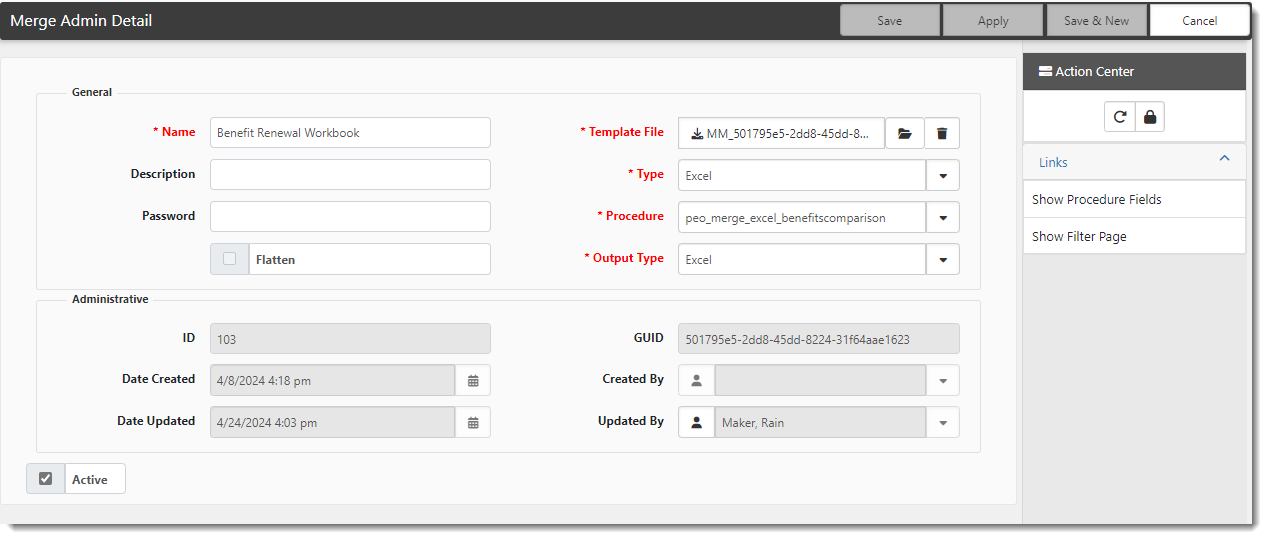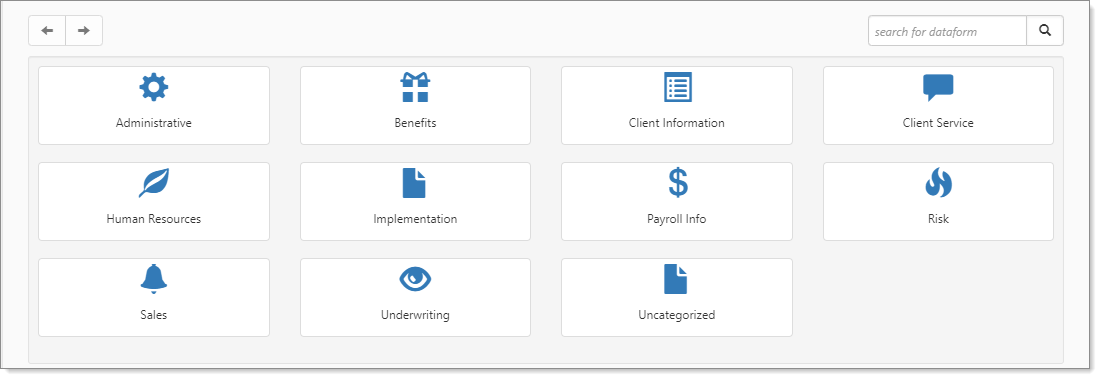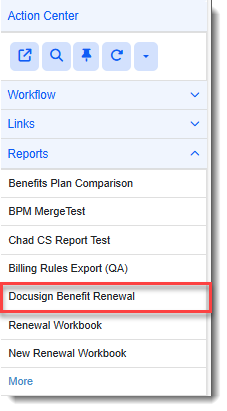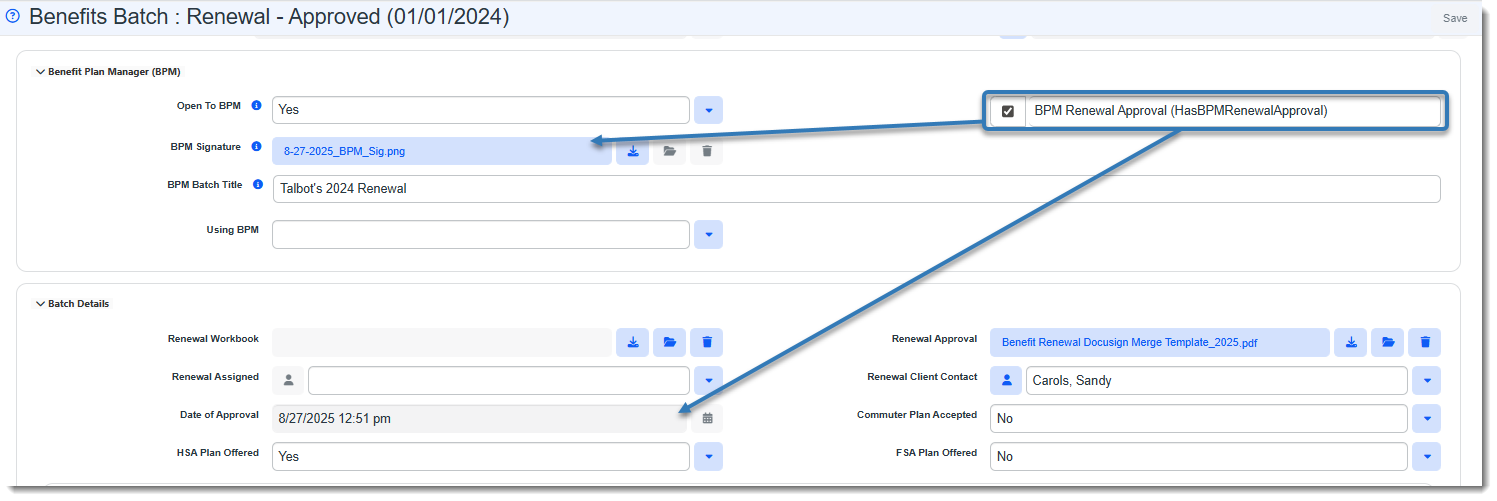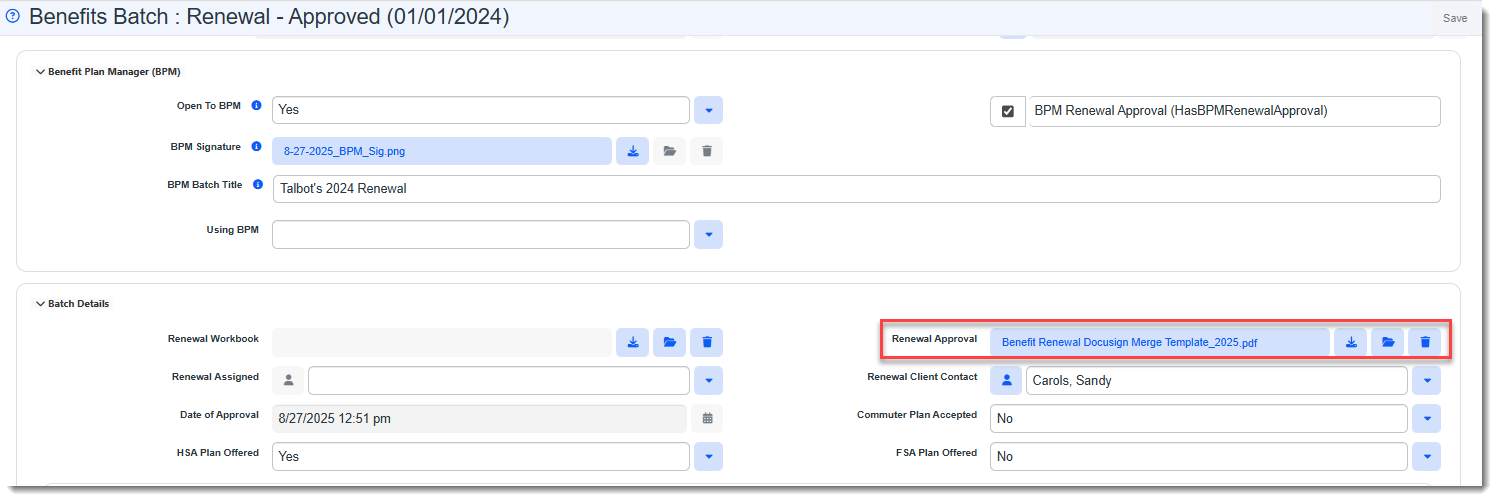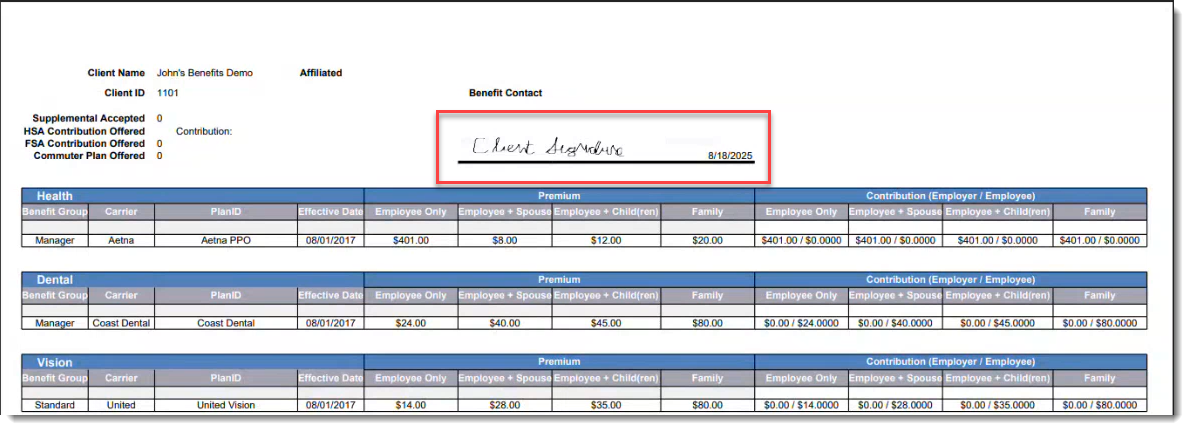Benefits Renewal Merge
The Benefits Renewal merge exports Benefits Plan details and Benefits Batch data from ClientSpace into an Excel Spreadsheet, referred to as the Benefits Renewal Workbook, so that you can analyze and compare the offered benefits for each benefits plan in a batch.
This topic covers configuration details, how to enter coverage counts and how to run the merge. There is also a demo video included.
Note: You can set up your own email template to use with DocuSign to get a client's approval on their selected Offered Benefit Plans (if you have DocuSign integration). If you use Benefit Plan Manager (BPM), ClientSpace will extract the BPM Signature and Date of Approval values from the Benefits Batch and print it on the Benefits Renewal DocuSign Approval merge document. The client-approved and signed document is stored on the Benefits Batch in the Renewal Approval field.
Even if you do not have DocuSign integration, you can still use the "DocuSign version" of the Benefits Renewal Merge to get client approval as this version contains a blank signature line when it is not auto-populated from DocuSign or by the BPM integration. See the Getting OBP Approval Using the DocuSign Benefit Renewal Merge section in this topic for additional details.
For a video demonstration on how to run the Benefits Renewal Merge and create the Benefits Renewal Workbook, also see Learning how: Creating a Benefits Renewal Workbook.
Configuration
Both the merge record and associated link are Active and available by default. The link is secured to the Benefits_Member role. Users with access permissions to view Merge Admin Detail configuration can go to System Admin![]() > Outputs > Merges and open the Benefit Renewal Workbook record:
> Outputs > Merges and open the Benefit Renewal Workbook record:
Note: No merge record configuration is required. However, if you want to use the Benefits Renewal Workbook as a DocuSign Approval merge document to store a client-approved copy of the report with the BPM signature and approval date on it, the 2025 DocuSign version of the template must be used (Benefit Renewal DocuSign Merge Template_2025) and the Output Type must be set to PDF as shown in the example below.
Entering Coverage Counts
While most of the information used in the spreadsheet calculations do not require user data entry, you are required to provide Coverage Count details on each Offered Benefits Plan record in the batch. These counts are used in the spreadsheet calculations.
Note: If you are running the Benefit Renewal Workbook Excel merge in a parent company workspace, ClientSpace also retrieves any coverage counts entered on child workspaces and displays a combined total for each Coverage Count shown in the spreadsheet if the following is True:
-
The parent company must be specified in the Benefit Parent Company field of the child Benefits Batch dataform.
-
There must be a policy and benefit group match found on an offered benefit plan in both the parent and child workspaces. For example, if the Parent Company has an offered benefit plan containing Policy A with a Benefit Group of B, the Child Company must also have an offered benefit plan containing Policy A with a Benefit Group of B.
Counts will not be combined on any offered benefits plans where there is not an exact match to the policy and benefit group in the parent and child workspaces.
To enter the Coverage Counts:
- Open the Benefits Batch record from which you want to run the Benefit Renewal Workbook Excel merge.
- From the modules bar, click
 Workspaces.
Workspaces.
The Workspace Search dashboard (i.e., workspace landing page) opens. - Select a workspace and click
 (Open).
(Open).
The Workspace page opens. Scroll down the page to the administrative tiles where you see the dataform categories.
Click Benefits and then click the Benefits Batch tile.
- From the modules bar, click
- On the Benefits Batch dataform, in the Action Center under Links, click Offered Benefit Plans.
- If there is only one offered benefit plan, the Offered Benefits Plan dataform displays the plan details. If there is more than one offered benefit plan, the Offered Benefits Plan dashboard displays. Click
 (Open) next to an offered benefit plan to display the plan details.
(Open) next to an offered benefit plan to display the plan details. - Scroll down to the Coverage Count sub-fieldset (located within the Coverage Details fieldset and fill in EOCount, ECCount, EKCount, ESCount, and EFCount fields:
EOCount = Employee Only coverage count
ECCount = Employee +Children coverage count
EKCount = Employee + Domestic Partner coverage count
ESCount = Employee + Spouse coverage count
EFCount = Employee + Family coverage count
-
Click Save or Apply.
-
If there is more than one offered benefit plan, return to the Offered Benefits Plan dashboard and repeat steps 4 and 5 until coverage counts are filled in for all offered benefit plans in the Benefits Batch.
Excluding a Plan from the Comparison
If there is a benefit plan you want to exclude from the calculations, click the Suppress From Presentation drop-down list and select one of the following options.
-
Suppress From Entire Presentation - Removes this plan from all locations in BPM and from the Benefits Renewal Workbook merge.
-
Suppress From Signature Page Only - Removes this plan only from the Signature Page in BPM and the Benefits Renewal DocuSign Approval merge.
-
Suppress From Plan Selection & Contributions Only - Removes this plan from the Plan Comparison and Summary pages in BPM and from the Benefits Renewal Workbook merge.
-
A suppressed plan will still be listed as an associated OBP on the Benefits Batch (when you click the Associated OBPs link in the Action Center of the Benefits Batch.)
-
Since suppression options can apply to multiple areas, including the Benefits Renewal Workbook merge, the Benefits Renewal DocuSign Approval merge, and BPM, carefully review the option definitions to ensure you are selecting the correct item.
Running the Merge
You can only run the merge on a Renewal batch (i.e., the batch type shown on the Benefits Batch dashboard must display Renewal in the Type column.)
To run the merge:
On the Benefits Batch from which you want to run the Benefit Renewal Workbook Excel merge, click the Renewal Workbook link located in the Action Center under Reports.
You can retrieve the merge document from your Windows Downloads folder.
Getting OBP Approval Using the DocuSign Benefit Renewal Merge
Getting OBP Approval Through DocuSign
You can use the DocuSign Benefit Renewal merge record and custom link and then set up your own email template to use with DocuSign if you have DocuSign integration. (See DocuSign Integration Overview and the Running the DocuSign Benefit Renewal Merge section below for additional details.)
Getting OBP Approval Without DocuSign - Blank Signature Line
If you do not have DocuSign integration, this document can still be used to obtain a signature even without DocuSign as it is a summary of selected OBPs and contains placeholders for the signature and signature date:
Getting OBP Approval through BPM and Saving the Signature to a DocuSign Benefit Renewal Merge PDF
Note: For this option, the Output type on the merge record must be set to PDF.
If you use BPM, once your customer has approved the Benefits Batch, click the DocuSign Benefit Renewal link under Reports in the Action Center to generate a signed Benefits Renewal Workbook containing the BPM Signature and Date of Approval. This document is stored as a PDF on the Benefits Batch in the Renewal Approval field.
(See the Running the DocuSign Benefit Renewal Merge section below for complete process details.)
Running the DocuSign Benefit Renewal Merge
Note: No merge record configuration is required. However, if you want to use the Benefits Renewal Workbook as a DocuSign Approval merge document to store a client-approved copy of the report with the BPM signature and approval date on it, the Output Type must be set to PDF as shown in the example below.
To run the DocuSign Benefit Renewal merge:
-
On the Benefits Batch from which you want to run the merge, click the DocuSign Benefit Renewal link located in the Action Center under Reports.
Clicking the link generates a Benefits Renewal DocuSign Approval Merge Template Excel file (or PDF if configured for use with BPM) in your Windows Downloads folder. The RenewalPlans tab displays a summary of selected OBPs and the ClientRenewalNotes tab displays exported notes from the Client Renewal Notes field on the Benefits Batch record.
Note: The Current Contribution and Renewal Contribution fields are rounded to 4-digit decimal precision.
Additional steps may occur after generating the report depending on your configuration:
DocuSign Integration
The DocuSign Benefit Renewal link may also trigger a DocuSign email template that sends the Excel or PDF file to email recipient(s) designated in the Email Template configuration out for electronic signature(s).
BPM Integration
The BPM Renewal Approval (HasBPMRenewalApproval) checkbox is automatically checked when the plan selection process is finalized by your customer in BPM. Once checked, the Benefits Batch tile in BPM changes to "Finalized" and your customer can no longer access the finalized Benefit Batch in BPM. The signature image and approval date are stored on the Benefits Batch in the BPM Signature and Date of Approval fields, respectively.
If you use the Benefits Renewal DocuSign Approval Merge Template, you can click the DocuSign Benefit Renewal link under Reports in the Action Center to generate a signed Benefits Renewal Workbook containing the BPM Signature and Date of Approval.
This document is stored as a PDF on the Benefits Batch in the Renewal Approval field where you can preview or download the report.
If your customer later requests a change to the finalized version of the Benefits Batch and you proceed with honoring the change request, you can manually uncheck the BPM Renewal Approval (HasBPMRenewalApproval)checkbox. This sets the Benefits Batch tile in BPM back to "Ready to Review" so that your customer can review the changes and sign off on them again on the BPM Signature/Selection Summary page. This also clears the BPM Signature and Date of Approval fields on the Benefits Batch. At this point, the Benefits Batch is no longer approved.
Two business rules are used to handle the clearing of the BPM Signature and Date of Approval fields:
-
Clear Signature Date (_ClearFieldValue) - Clears the Benefits Batch Date of Approval field when a batch is no longer approved (i.e., when you uncheck the BPM Renewal Approval (HasBPMRenewalApproval) checkbox.)
-
DocuSign Approval - No Signature (_GenerateMergeFile)- Reruns the merge without a signature if the approval is removed when a batch is no longer approved (i.e., when you uncheck the BPM Renewal Approval (HasBPMRenewalApproval) checkbox) and places an unsigned version of the PDF merge output in the Renewal Approval field. This version contains a blank signature line in place of the signature and date.
Once your customer approves the new changes, the following occurs:
-
The BPM Renewal Approval (HasBPMRenewalApproval) checkbox is automatically checked again.
-
The new signature is stored in the BPM Signature field.
If you had previously generated a Benefits Renewal DocuSign Approval using the DocuSign Benefit Renewal link in the Action Center Reports section, you can click the link again to regenerate the report and repopulate the Renewal Approval field with a newly signed and dated version of the approved benefits.
